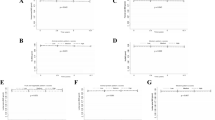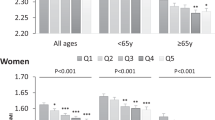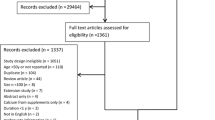Abstract
Objectives:
To assess the effectiveness of a multivitamin (MV) tablet on nutritional status, quantitative heel ultrasound (QUS), mobility, muscle strength and falls. The design comprised two groups matched on mobility levels, randomized to receive a daily MV or placebo (P) tablet for 6 months. The setting was an Australian residential care facility.
Subjects:
A total of 92 aged care residents. Serum micronutrients, body weight, QUS, rate of falls, hand grip strength, and the timed up and go test were assessed at baseline and 6 months.
Results:
A total of 49 participants consumed a MV and 43, a matched P for 6 months. There was a greater increase in the MV vs P group for serum 25(OH)D (mean difference±standard error, 33.4±2.6 nmol l−1), folate (13.4±2.8 nmol l−1), and vitamin B12 (178.0±40.3 pmol l−1) (all P<0.001). Adequate 25(OH)D concentrations (⩾50 nmol l−1) were found among 77% of participants in the MV group vs 10% taking P (P<0.001). Adjusting for baseline levels, the increase in QUS was greater in the MV vs P group (3.0±2.0 dB MHz−1 vs −2.9±2.1 dB MHz−1, respectively, P=0.041). There was a trend towards a 63% lower mean number of falls in the MV vs P group (0.3±0.1 falls vs 0.8±0.3 falls, P=0.078).
Conclusions:
MV supplementation raised serum vitamin B12 and folate concentrations and increased serum 25(OH)D, which was accompanied by an apparent positive effect on bone density. We also found a trend towards a reduction in falls and this could contribute to a reduction in fractures.
This is a preview of subscription content, access via your institution
Access options
Subscribe to this journal
Receive 12 print issues and online access
$259.00 per year
only $21.58 per issue
Buy this article
- Purchase on Springer Link
- Instant access to full article PDF
Prices may be subject to local taxes which are calculated during checkout



Similar content being viewed by others
References
Abbasi AA, Rudman D (1993). Observations on the prevalence of protein-calorie undernutrition in VA nursing homes. J Am Geriatr Soc 41, 117–121.
Alhamdan AA (2004). Nutritional status of Saudi males living in the Riyadh nursing home. Asia Pac J Clin Nutr 13, 372–376.
Arinzon Z, Fidelman Z, Peisakh A, Adunsky A (2004). Folate status and folate related anemia: a comparative cross-sectional study of long-term care and post-acute care psychogeriatric patients. Arch Gerontol Geriatr 39, 133–142.
Avenell A, Campbell MK, Cook JA, Hannaford PC, Kilonzo MM, McNeill G et al. (2005). Effect of multivitamin and multimineral supplements on morbidity from infections in older people (MAVIS trial): pragmatic, randomised, double blind, placebo controlled trial. BMJ 331, 324–329.
Barr SI, Chrysomilides SA, Willis EJ, Beattie BL (1984). Food intake of institutionalized women over 80 years of age. J Can Diet Assoc 45, 42–51.
Bender DA (2002). Daily doses of multivitamin tablets. BMJ 325, 173–174.
Broe KE, Chen TC, Weinberg J, Bischoff-Ferrari HA, Holick MF, Kiel DP (2007). A higher dose of vitamin D reduces the risk of falls in nursing home residents: a randomized, multiple-dose study. J Am Geriatr Soc 55, 234–239.
Chapuy MC, Arlot ME, Duboeuf F, Brun J, Crouzet B, Arnaud S et al. (1992). Vitamin D3 and calcium to prevent hip fractures in the elderly women. N Engl J Med 327, 1637–1642.
Clarke R, Grimley Evans J, Schneede J, Nexo E, Bates C, Fletcher A et al. (2004). Vitamin B12 and folate deficiency in later life. Age Ageing 33, 34–41.
Dharmarajan TS, Ugalino JT, Kanagala M, Pitchumoni S, Norkus EP (2000). Vitamin B12 status in hospitalized elderly from nursing homes and the community. J Am Med Dir Assoc 1, 21–24.
Diamond TH, Ho KW, Rohl PG, Meerkin M (2005). Annual intramuscular injection of a megadose of cholecalciferol for treatment of vitamin D deficiency: efficacy and safety data. Med J Aust 183, 10–12.
Essama-Tjani JC, Guilland JC, Potier de Courcy G, Fuchs F, Richard D (2000). Folate status worsens in recently institutionalized elderly people without evidence of functional deterioration. J Am Coll Nutr 19, 392–404.
Fawzi W, Stampfer MJ (2003). A role for multivitamins in infection? Ann Intern Med 138, 430–431.
Flicker L, MacInnis RJ, Stein MS, Scherer SC, Mead KE, Nowson CA et al. (2005). Should older people in residential care receive vitamin D to prevent falls? Results of a randomized trial. J Am Geriatr Soc 53, 1881–1888.
Flicker L, Mead K, MacInnis RJ, Nowson C, Scherer S, Stein MS et al. (2003). Serum vitamin D and falls in older women in residential care in Australia. J Am Geriatr Soc 51, 1533–1538.
Fraser D (1990). Vitamin D: Recommended Nutrient Intakes. Australian Professional Publications: Sydney.
Grados F, Brazier M, Kamel S, Duver S, Heurtebize N, Maamer M et al. (2003). Effects on bone mineral density of calcium and vitamin D supplementation in elderly women with vitamin D deficiency. Joint Bone Spine 70, 203–208.
Grieger J, Nowson C, Ackland ML (2007). Anthropometric and biochemical markers for nutritional risk among residents within an Australian residential care facility. Asia Pac J Clin Nutr 16, 178–186.
Grieger JA, Nowson CA (2007). Nutrient intake and plate waste from an Australian residential care facility. Eur J Clin Nutr 61, 655–663.
Huerta JM, Gonzalez S, Vigil E, Prada M, San Martin J, Fernandez S et al. (2004). Folate and cobalamin synergistically decrease the risk of high plasma homocysteine in a nonsupplemented elderly institutionalized population. Clin Biochem 37, 904–910.
Krieg MA, Jacquet AF, Bremgartner M, Cuttelod S, Thiebaud D, Burckhardt P (1999). Effect of supplementation with vitamin D3 and calcium on quantitative ultrasound of bone in elderly institutionalized women: a longitudinal study. Osteoporos Int 9, 483–488.
Krieg MA, Thiebaud D, Burckhardt P (1996). Quantitative ultrasound of bone in institutionalized elderly women: a cross-sectional and longitudinal study. Osteoporos Int 6, 189–195.
Law M, Withers H, Morris J, Anderson F (2006). Vitamin D supplementation and the prevention of fractures and falls: results of a randomised trial in elderly people in residential accommodation. Age Ageing 35, 482–486.
Mann BA, Garry PJ, Hunt WC, Owen GM, Goodwin JS (1987). Daily multivitamin supplementation and vitamin blood levels in the elderly: a randomized, double-blind, placebo-controlled trial. J Am Geriatr Soc 35, 302–306.
McKay DL, Perrone G, Rasmussen H, Dallal G, Blumberg JB (2000a). Multivitamin/mineral supplementation improves plasma B-vitamin status and homocysteine concentration in healthy older adults consuming a folate-fortified diet. J Nutr 130, 3090–3096.
McKay DL, Perrone G, Rasmussen H, Dallal G, Hartman W, Cao G et al. (2000b). The effects of a multivitamin/mineral supplement on micronutrient status, antioxidant capacity and cytokine production in healthy older adults consuming a fortified diet. J Am Coll Nutr 19, 613–621.
NHMRC (2006). Nutrient Reference Values for Australia and New Zealand Including Recommended Dietary Intakes. National Health and Medical Research Council: Canberra.
Nowson CA, Sherwin AJ, McPhee JG, Wark JD, Flicker L (2003). Energy, protein, calcium, vitamin D and fibre intakes from meals in residential care establishments in Australia. Asia Pac J Clin Nutr 12, 172–177.
Paul AAS, Southgate D (1979). The Composition of Foods, 4th edn. Her Majesty's Stationary Office: London.
Peacock M, Liu G, Carey M, McClintock R, Ambrosius W, Hui S et al. (2000). Effect of calcium or 25OH vitamin D3 dietary supplementation on bone loss at the hip in men and women over the age of 60. J Clin Endocrinol Metab 85, 3011–3019.
Pepersack T, Rotsaert P, Benoit F, Willems D, Fuss M, Bourdoux P et al. (2001). Prevalence of zinc deficiency and its clinical relevance among hospitalised elderly. Arch Gerontol Geriatr 33, 243–253.
Sato Y, Honda Y, Iwamoto J, Kanoko T, Satoh K (2005). Effect of folate and mecobalamin on hip fractures in patients with stroke: a randomized controlled trial. JAMA 293, 1082–1088.
Schott AM, Hans D, Garnero P, Sornay-Rendu E, Delmas PD, Meunier PJ (1995). Age-related changes in Os calcis ultrasonic indices: a 2-year prospective study. Osteoporos Int 5, 478–483.
Stein MS, Scherer SC, Walton SL, Gilbert RE, Ebeling PR, Flicker L et al. (1996). Risk factors for secondary hyperparathyroidism in a nursing home population. Clin Endocrinol (Oxf) 44, 375–383.
Acknowledgements
The researchers greatly appreciate the assistance of Anthony Worsely (Professor of Public Health Nutrition) from Deakin University. We also greatly appreciate the assistance of a number of people from Barwon Health, Aged Care, including the nursing director, general practitioners, unit nurse managers, and staff from Environmental Services, Allied Health, Supply and Food Services. Finally, we thank all the residents who participated in the intervention for their invaluable cooperation. This study was funded by Murray Goulbourn Co-operative Co. Ltd, Sigma Australia Pharmaceuticals Company Pty and the Australian Research Council (Linkage-Projects), but had no input into the results presented in this report.
Author information
Authors and Affiliations
Corresponding author
Additional information
Contributors: CAN was the chief investigator for this study whose major role was initiating the trial, designing the study objectives and specifying the best method for data collection. CAN also provided support with the statistical analyses, data interpretation and the compilation of the completed manuscript. JAG was the PhD student involved in acquisition of subjects, data collection, statistical analyses, interpreting results and the compilation of this manuscript. HFJ and RM were the co-investigators of the project, contributing to the initial development and design of the study objectives, and reviewing of the manuscript. LMA contributed in the measurement of serum zinc and reviewing the manuscript.
Rights and permissions
About this article
Cite this article
Grieger, J., Nowson, C., Jarman, H. et al. Multivitamin supplementation improves nutritional status and bone quality in aged care residents. Eur J Clin Nutr 63, 558–565 (2009). https://doi.org/10.1038/sj.ejcn.1602963
Received:
Revised:
Accepted:
Published:
Issue Date:
DOI: https://doi.org/10.1038/sj.ejcn.1602963
Keywords
This article is cited by
-
Increasing the uptake of vitamin D supplement use in Australian residential aged care facilities: results from the vitamin D implementation (ViDAus) study
BMC Geriatrics (2020)
-
Prevalence of vitamin D supplement use in Australian residential aged care facilities in November 2014
BMC Research Notes (2017)
-
Serum folate predicts muscle strength: a pilot cross-sectional study of the association between serum vitamin levels and muscle strength and gait measures in patients >65 years old with diabetes mellitus in a primary care setting
Nutrition Journal (2016)
-
Multivitamin and mineral supplementation is associated with the reduction of fracture risk and hospitalization rate in Chinese adult males: a randomized controlled study
Journal of Bone and Mineral Metabolism (2015)



